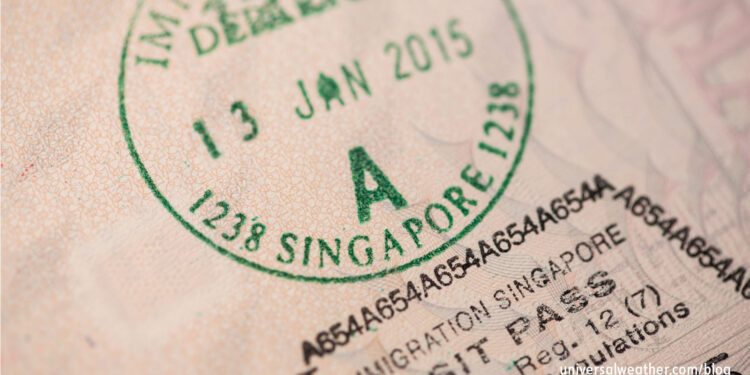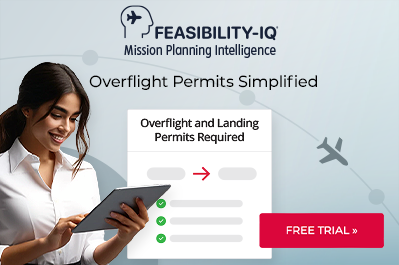Bizjet Operations into Singapore – Part 2: Permits and CIQ

This is a post by author Yvonne Chan. Yvonne is managing director for Universal Aviation Singapore, which has an aircraft ground-handling facility in Seletar. Yvonne is an expert on business aircraft operations in Singapore and can be contacted at yvonnechan@universalaviation.aero.
This business aviation blog post continues from our article last week, entitled “Bizjet Operations into Singapore – Part 1: Airports, Slots & Parking .”
While Singapore is a welcoming business aviation operating environment with good services and facilities, there are permit requirements to consider for charter (non-scheduled commercial) and certain private non-revenue operators. Additionally, be aware of the customs and immigration entry requirements into the country, along with yellow fever vaccination requirements.
The following is an overview of what you need to know:
1. Landing permits
Landing permits for Singapore are only required for charter operators and private non-revenue aircraft without standard airworthiness certificates. Normal private non-revenue operations to Singapore do not require landing permits.
2. Landing permit lead time
Foreign-registered charter operators flying to Singapore must apply for, and obtain prior approval from, the Civil Aviation Authority of Singapore (CAAS). These approvals take the form of an Operations Permit and an Air Transport (AT) Permit. Lead time considerations are important to consider for both permits.
3. Air Operations Permit
An Air Operations Permit takes three working days to process; however, as CAAS needs to review all documentation and ensure that all charter operator requirements are met, the processing time may take up to three weeks. Note that you may have up to 20 aircraft on an Air Operations Permit. Once this permit is approved, CAAS will advise on the validity period which may only be valid for up to one year. This is due to aircraft insurance and other documentation expiration dates. Be mindful, however, that this permit is only valid as long as your aircraft insurance remains valid. Your airworthiness certificate, also, must be up-to-date and have an expiration date noted. If your airworthiness certificate does not have an expiration date, you’ll need to submit aircraft maintenance documentation to prove that the aircraft is current on all airworthiness requirements.
07/15/2015: Update by author
4. Aging aircraft considerations
Charter aircraft older than 20 years must have a special maintenance program approved by the operator’s State of Registry or by the manufacturer. The program may include, but is not limited to, the following items:
- Supplemental Inspection Program or Airworthiness Limitations Structural Inspections
- Supplemental Structural Inspection Program
- Corrosion Prevention Control Program
- Repair Assessment Program
- Evaluation for widespread fatigue damage
5. AT permits
Once you have your Operations Permit, you’ll also need an AT permit for each entry into Singapore. CAAS issues AT permits, and they’re open 24 hours in case of short-notice requests. For AT permits no additional documentation needs to be submitted, but a few hours’ lead time is involved for approval.
6. Landing permit requirements
There are many documents required for the Air Operations Permit request. Below you will find some of the documents needed:
- Air Operators Certificate
- Associated Operations Specifications
- Certificate of Airworthiness and / or Airworthiness Review Certificate (if any)
- Certificate of Registration
- Aging aircraft program approved by state of operator if the aircraft is more than 20 years old
- Certificate of insurance
*For the full list of documents, please contact your 3rd-party provider.
7. CIQ clearance
Upon arrival at WSSS, passengers will be escorted by their ground handler, in a vehicle, from the aircraft to the Commercially Important Person (CIP) terminal to clear Customs, Immigration, and Quarantine (CIQ). In the case of WSSL, passengers are transported to the terminal for clearance. Once the crew members are ready to leave the aircraft, they’ll be escorted to the appropriate clearance area. The CIP terminal at WSSS offers more convenient, private, and faster CIQ clearance, but there are costs associated – about $2,000 USD for up to nine passengers and crew members or a per arrival/per departure basis. For WSSL all passengers/crew members clear at the main terminal. This process is typically quick as there are currently no scheduled commercial ops at this airport. Be aware, however, that as of 2017 schedule commercial flights will begin at WSSL – at a new terminal – so GA terminal clearance could become a somewhat slower process.
8. CIQ documentation and security screening
Upon arrival in Singapore, all passengers and crew members must present passports valid for their length of stay in country. Your ground handler will look after transporting all pieces of luggage to the CIQ clearance area. For outbound immigration clearance, you’ll present your passport and be security-screened with your luggage, before being escorted to the aircraft. Some nationalities of passengers require visas to enter Singapore. It’s important to understand that no visas are issued on arrival. If a passenger arrives without a required visa, he/she may be immediately deported.
Crew members on chartered flights do not need visas for Singapore, regardless of nationality, as they’re issued “shore passes.” This visa-free arrangement (shore passes) applies to pilots, flight attendants, and flight mechanics so long as they’re listed on the gen dec as crew members. However, crew members on private non-revenue flights will clear CIQ as passengers and visa requirements will apply.
9. Noise restrictions
Stage 2 aircraft are prohibited from operating to Singapore. To operate here, you must possess a noise certificate stating your aircraft meets International Civil Aviation Organization Annex 16, Volume 1, Chapter 3 or equivalent standards. Note that noise certificates must be in the form of a document approved by the State of Registry of the aircraft.
10. Vaccination requirements
Yellow fever vaccination certificates are required for all travelers over the age of one who, within the preceding six days, have been in or passed through any country endemic for yellow fever. Note that a yellow fever vaccination is good for a period of 10 years but does not become valid or effective until 10 days after the vaccination. The following are countries Singapore currently (as of time of this article) considers endemic for yellow fever:
|
Angola |
Argentina |
Benin |
|
Bolivia |
Brazil |
Burkina Faso |
|
Burundi |
Cameroon |
Central African Republic |
|
Chad |
Colombia |
Congo |
|
Cote d’Ivoire |
Democratic Republic of Congo |
Ecuador |
|
Equatorial Guinea |
Ethiopia |
French Guyana |
|
Gabon |
Gambia |
Ghana |
|
Guinea-Bissau |
Guyana |
Kenya |
|
Liberia |
Mali |
Mauritania |
|
Niger |
Nigeria |
Panama |
|
Paraguay |
Peru |
Rwanda |
|
Sao Tome and Principe |
Senegal |
Sierra Leone |
|
Somalia |
Sudan |
Suriname |
|
Togo |
Trinidad and Tobago |
Uganda |
|
United Republic of Tanzania |
Venezuela |
|
For more information on yellow fever requirements, see the Immigration & Checkpoints Authority website.
Conclusion
Be aware of documentation requirements for entry into the country for both crew members and passengers. Note that the air operations permits require approximately three weeks to process, so it’s best to request these permits even though you may not have a trip to this country scheduled yet.
Questions?
If you have any questions about this article or would like assistance planning your next trip to Singapore, contact me at yvonnechan@universalaviation.aero.




